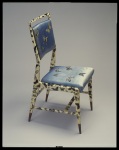THE FIFTIES: THE THEORY OF "THE FINITE FORM"
It was in 1954 that Ponti published, with Daria Guarnati, the first book dealing with his own work, and he called it Espressione di Gio Ponti.He had reached the point where he could take a critical look at his own history as continuity of an individual expression. And he did it at the moment when this expression appeared to have been unified by a theory about form (for the first time): the theory of the finite form. Ponti perceived the form of each of his projects in his own terms from essentiality to expressiveness, illusoriness, and structural invention (but with him theory too was an invention).
In the fabulous fifties, very productive years for Ponti in the fields of both architecture and design, before and after the Pirelli Tower, 1956, which represented their climax, before and after his great journeys (to Brazil, Mexico, Venezuela, the USA, and the Middle East) Ponti's works from car bodies to skyscrapers had a formal relationship with each other; they came from an imaginative treatment of form that evolved out of itself. In this creative and individual manner, Ponti opposed both recourse to the existing context and the international style terms of the debate under way at that time.
Gio Ponti was in his sixties. They were years in which the masters, from Gropius to Le Corbusier, gained a new vision, as masters/non-masters, on the new world scene. During the fifties Ponti's studio in Milan and the magazine Domus gradually turned into international workshops, against a background of explosive growth in the world of both architecture and design. Ponti's book from 1945 (L'architettura è un cristallo), republished in 1957 became Amate I'architettura, his diary-cum-notebook of ideas, and was soon translated into English In Praise of Architecture and Japanese.
During these years Gio Ponti was associated with the engineer Antonio Fornaroli and the architect Alberto Rosselli, in the Studio Ponti Fornaroli Rosselli, 1952-76.
From "Gio Ponti, l'opera" by Lisa Licitra Ponti,1990, Leonardo Editore
-
1950
-
1950
-
1950
-
1950 - 1958
-
1951 - 1957
-
1953
-
1954
-
1956 - 1962
-
1957
-
1957
-
1957 - 1964
-
1958
-
1959
-
1959























































































